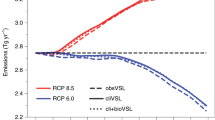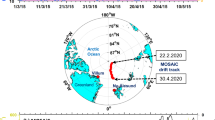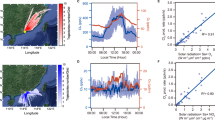Abstract
RECENT measurements of inorganic chlorine gases1 and hydrocarbons2 indicate the presence of reactive chlorine in the remote marine boundary layer; reactions involving chlorine and bromine can affect the concentrations of ozone, hydrocarbons and cloud condensation nuclei. The known formation mechanisms of reactive halogens require significant concentrations of nitrogen oxides3–5, which are not present in the unpolluted air of the remote marine boundary layer6. Here we propose an autocatalytic mechanism for halogen release from sea-salt aerosol: gaseous HOBr is scavenged by the aerosol and converted to only slightly soluble BrCl and Br2, which are released into the gas phase. Depending on the sea-salt concentration and given a boundary layer that is stable for a few days, gaseous HOCl and HOBr may reach molar mixing ratios of up to 35 pmol mol−1. We calculate that HOBr and HOCl are responsible for 20% and 40%, respectively, of the sulphur (IV) oxidation7,8 that occurs in the aerosol phase. The additional S(IV) oxidation reduces the formation of cloud-condensation nuclei, and hence the feedback between greenhouse warming, oceanic DMS emission and cloud albedo. We also calculate significant bromine-catalysed ozone loss.
This is a preview of subscription content, access via your institution
Access options
Subscribe to this journal
Receive 51 print issues and online access
$199.00 per year
only $3.90 per issue
Buy this article
- Purchase on Springer Link
- Instant access to full article PDF
Prices may be subject to local taxes which are calculated during checkout
Similar content being viewed by others
References
Pszenny, A. A. P. et al. Geophys. Res. Lett. 20, 699–702 (1993).
Singh, H. B. et al. J. Geophys. Res. 101, 1907–1917 (1996).
Finlayson-Pitts, B. J. Res. Chem. Intermediates 19, 235–249 (1993).
Zetzsch, C. & Behnke, W. Ber. Bunsenges. Phys. Chem. 96, 488–493 (1992).
Finlayson-Pitts, B. J., Livingston, F. E. & Berko, H. N. J. Phys. Chem. 93, 4397–4400 (1989).
Rohrer, F. & Bruening, D. J. Atmos. Chem. 15, 253–267 (1992).
Fogelman, K. D., Walker, D. M. & Margerum, D. W. Inorg. Chem. 28, 986–993 (1989).
Troy, R. C. & Margerum, D. W. Inorg. Chem. 30, 3538–3543 (1991).
Finlayson-Pitts, B. J. J. Geophys. Res. 98D, 14991–14993 (1993).
Parrish, D. D. et al. J. Geophys. Res. 98D, 14995–14997 (1993).
McKeen, S. A. & Liu, S. C. Geophys. Res. Lett. 20, 2363–2366 (1993).
Wingenter, O. W. et al. J. Geophys. Res. 101, 4331–4340 (1996).
Graedel, T. E. & Keene, W. C. Global Biogeochem. Cycles 9(1), 47–77 (1995).
Jobson, B. T. et al. J. Geophys. Res. 99D, 25355–25368 (1994).
Barrie, L. A., Bottenheim, J. W., Schnell, R. C., Crutzen, P. J. & Rasmussen, R. A. Nature 334, 138–141 (1988).
Hausmann, M. & Platt, U. J. Geophys. Res. 99D, 25399–25413 (1994).
Singh, H. B. & Kasting, J. F. J. Atmos. Chem. 7, 261–285 (1988).
Harris, G. W., Klemp, D. & Zenker, T. J. Atmos. Chem. 15, 327–332 (1992).
Mozurkewich, M. J. Geophys. Res. 100(D), 14199–14207 (1995).
Wang, T. X., Kelley, M. D., Cooper, J. N., Beckwith, R. C. & Margerum, D. W. Inorg. Chem. 33, 5872–5878 (1994).
Eigen, M. & Kustin, K. J. Am. Chem. Soc. 84, 1355–1361 (1962).
Fan, S.-M. & Jacob, D. J. Nature 359, 522–524 (1992).
Sander, R. & Crutzen, P. J. J. Geophys. Res. 101, 9121–9138 (1996).
Kim, Y., Sievering, H. & Boatman, J. Glob. Biogeochem. Cycles 4, 165–177 (1990).
Kim, Y., Sievering, H., Boatman, J., Wellman, D. & Pszenny, A. J. Geophys. Res. 100, 23027–23038 (1995).
Chameides, W. L. & Stelson, A. W. J. Geophys. Res. 97D, 20565–20580 (1992).
Charlson, R. J., Lovelock, J. E., Andreae, M. O. & Warren, S. G. Nature 326, 655–661 (1987).
Sievering, H. et al. Nature 360, 571–573 (1992).
Huthwelker, T. et al. J. Atmos. Chem. 21, 81–95 (1995).
Behnke, W., Elend, M., Krüger, H. U., Scheer, V. & Zetzsch, C. in Proc. Eurotrac Symp. (eds Borrell, P. M. et al.) (Computational Mechanics, Southampton, in the press).
Author information
Authors and Affiliations
Rights and permissions
About this article
Cite this article
Vogt, R., Crutzen, P. & Sander, R. A mechanism for halogen release from sea-salt aerosol in the remote marine boundary layer. Nature 383, 327–330 (1996). https://doi.org/10.1038/383327a0
Received:
Accepted:
Issue Date:
DOI: https://doi.org/10.1038/383327a0
This article is cited by
-
Halogens in chondritic meteorites and terrestrial accretion
Nature (2017)
-
Photochemical activation of chlorine by iron-oxide aerosol
Journal of Atmospheric Chemistry (2017)
-
Exploring the potential energy surface of novel [H, S, Se, Br] species: a high level first principle study
Journal of Molecular Modeling (2017)
-
Canadian Arctic sea ice reconstructed from bromine in the Greenland NEEM ice core
Scientific Reports (2016)
-
Reactions of Cl atoms with alkyl esters: kinetic, mechanism and atmospheric implications
Environmental Science and Pollution Research (2015)
Comments
By submitting a comment you agree to abide by our Terms and Community Guidelines. If you find something abusive or that does not comply with our terms or guidelines please flag it as inappropriate.



